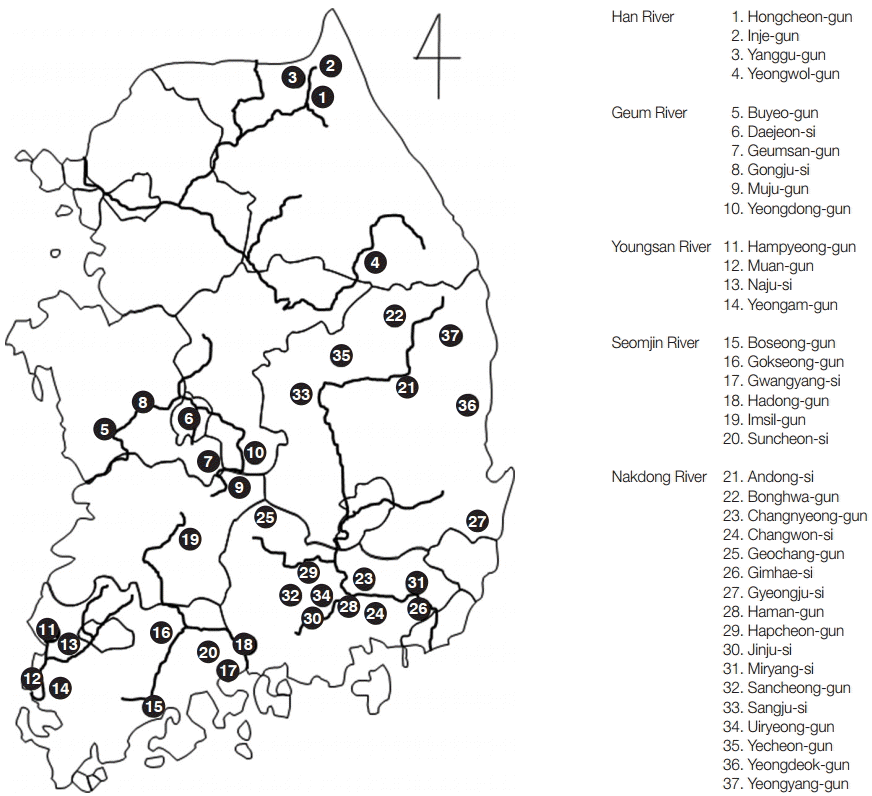Until the 1970s in the Republic of Korea (Korea), parasitic infections with soil-transmitted intestinal nematodes, such as Ascaris lumbricoides, Trichuris trichiura, and hookworms, were highly prevalent [1,2]. Since 1971, nationwide surveys have been conducted every 5-7 years in order to estimate the infection status of intestinal helminth parasites until 2004 [3]. In the first 1971 survey, the overall prevalence was 84.3%, and by 2004, the rate had dramatically decreased to 3.7%. The rapid decrease in the overall prevalence of intestinal parasites over the past several decades has been attributed mainly to nationwide control programs and health education initiatives undertaken by the Korean government along with improvements in the living conditions and quality of life in Korea [4]. Despite the remarkable decrease of soil-transmitted nematode infections, the prevalence of fish-borne trematode infections such as clonorchiasis and metagonimiasis has still remained to be relatively high [5].
The liver fluke, C. sinensis, is the most important helminth in Korea these days, and clonorchiasis has been known as the cause of biliary pathogenesis, i.e., inflammation, dilatation, wall thickening, mucosal hyperplasia, liver cirrhosis, and even cholangiocarcinoma [6-8]. Among human diseases caused by parasites, clonorchiasis is ranked at the first due to its social, economic, and public health impacts in Korea. Clonorchiasis is endemic in most of the major river basins of Korea [9]. In 1981, the egg positive rates of people living in those river basins differed considerably; 40.2% in Nakdong River, 30.8% in Yeongsan River, 17.3% in Seomjin River, 15.7% in Han River, 15.9% in Tamjin River, and 12.0% in Geum River [10]. However, in 2007, the positive rates of C. sinensis in Nakdong, Seomjin, Yeongsan, Geum, and Han Rivers were 12.2%, 9.5%, 3.3%, 3.0%, and 1.0%, respectively [11]. Although the infection rates of C. sinensis in these major rivers decreased considerably over the past 20 years, clonorchiasis continues to persist and is currently considered as the most important helminthiasis in Korea.
In this study, we investigated the infection status of populations identified to be at risk of clonorchiasis, notably among residents living along 5 major rivers. The surveyed areas consisted of 37 counties, which are located in the vicinity of the Han, Geum, Yeongsan, Seomjin, and Nakdong Rivers, Korea. A total of 42,562 fecal specimens were collected from residents of these regions using a random household sampling method from February to November 2008 (Fig. 1). Stool specimens in plastic containers (1/person) collected in individual survey areas were transferred to the laboratory of National Institute of Health, and then examined by means of the formalin-ether sedimentation technique. Microscopic examinations were performed twice by well-trained technicians. The egg positive rate was estimated by arithmetic means. The egg positive individuals were treated with either praziquantel or other appropriate anti-parasitic drugs at the end of the study.
More than 10 species of helminth eggs were detected in 4,052 (9.5%) stool samples (Table 1). Eggs of C. sinensis were found in 3,586 (8.4%) fecal specimens of residents. The prevalence of clonorchiasis was highest in residents of Nakdong River (11.7%), followed by Seomjin River (9.9%), Geum River (6.5%), Yeongsan River (3.1%), and Han River (1.0%). Especially, Gyeongju-si (city) had the highest rate of 25.9%, followed by Hadong-gun of 21.9%, which were located in the mid- or downstream of Nakdong and Seomjin Rivers, respectively. Egg positive rates by surveyed areas are shown in Table 2.
The overall prevalence of clonorchiasis by sex was 11.2% in males and 6.2% in females (Table 3). The egg positive rate by age group was highest in the 50-59 age band, followed by the forties (8.9%), sixties (8.8%), seventies (7.8%), thirties (5.7%), over 80 (5.2%), twenties (2.2%), and below 19 (1.0%) (Table 4).
The present study provided the prevalence of C. sinensis infection among residents living along 5 major rivers of Korea and confirmed the high endemicity of C. sinensis infection in southern localities. Although the prevalence of clonorchiasis along the major rivers appears to decline over the past decade, we identified that Nakdong and Seomjin Rivers are still highly endemic regions in common with previous studies; a national survey undertaken in 1981 reported that the egg positive rates of people living along these major river basins were 40.2% in Nakdong River, 30.8% in Yeongsan River, 17.3% in Seomjin River, 15.7% in Han River, 15.9% in Tamjin River, and 12.0% in Geum River [10]. Also, in 2006, the egg positive rates of C. sinensis observed in the river basins of Nakdong, Seomjin, Yeongsan, and Geum were 17.1%, 11.2%, 5.5%, and 4.6%, respectively [9]. In addition, our results showed that the positive rates of overall intestinal parasites and C. sinensis in residents along 5 major rivers was 9.5% and 8.4%, respectively. The 9.5% prevalence of overall intestinal parasites is 2-fold higher than the national intestinal helminth prevalence of 3.7% in 2004 [3].
The infection status of C. sinensis according to age groups appears to be a typical pattern for C. sinensis infection, reaching a peak at the age groups of 40-49 and 50-59 years. These results suggest that the eating habit of raw fishes containing C. sinensis metacercariae is a deeply rooted traditional custom among residents living in rural and riverside areas. As well, the higher prevalence in males than in females may be caused by frequent alcohol consumption and raw freshwater fish intake with increasing activities such as fishing that are mostly carried out by men.
While not conceptually new, our results provided the basic data and important information regarding the prevalence of clonorchiasis in high risk regions in Korea and are valuable for providing control strategies and medication of clonorchiasis patients in these areas.




